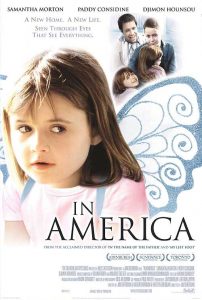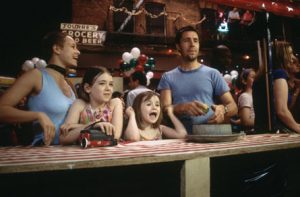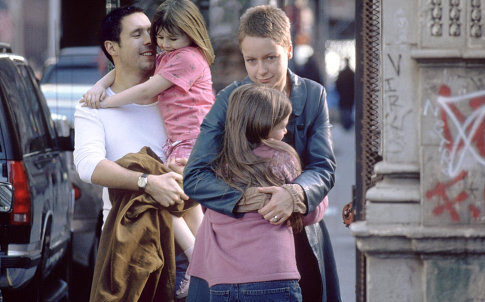By: Jessica Heskett
 The Irish filmmaker, Jim Sheridan, directs the 2002 film, In America. This film tells the story of a family of Irish emigrants who struggle to find their way in New York City after the loss of their young son. With the help of his two daughters, Jim Sheridan wrote this film based upon their lives. When Sheridan was 17, his younger brother, Frankie, died from a brain tumor. As a way for Sheridan to grieve and honor his late brother, the character Frankie is included in the film. The family’s struggles with poverty and immigration in America are taken from Sheridan’s experiences when he moved his family to New York City in the 1980s. Sheridan has notable accomplishments in film, writing or directing such movies as My Left Foot, The Field, and In the Name of the Father. Collectively, these films received 13 Academy Award nominations.
The Irish filmmaker, Jim Sheridan, directs the 2002 film, In America. This film tells the story of a family of Irish emigrants who struggle to find their way in New York City after the loss of their young son. With the help of his two daughters, Jim Sheridan wrote this film based upon their lives. When Sheridan was 17, his younger brother, Frankie, died from a brain tumor. As a way for Sheridan to grieve and honor his late brother, the character Frankie is included in the film. The family’s struggles with poverty and immigration in America are taken from Sheridan’s experiences when he moved his family to New York City in the 1980s. Sheridan has notable accomplishments in film, writing or directing such movies as My Left Foot, The Field, and In the Name of the Father. Collectively, these films received 13 Academy Award nominations.
 The story begins with the family attempting to enter America through Canada. This is where the viewer learns about the death of the youngest brother, Frankie, who died of a brain tumor. The whole movie centers on Frankie and how he is haunting their family through the struggles the parents are coming across, such as job placement. The father is an actor and the mother is a teacher, who has to settle for work as a server at an ice cream parlor. As newcomers to New York City and immigrants from Ireland, the girls attend a Catholic school the family can barely afford. When Ariel and Christy arrive at the school Halloween party in their homemade costumes, everyone whispers about how the girls are poor Irish, due to their attire. What isn’t understood by their classmates is the differences between Halloween celebrations – and costumes – between Ireland and America. At a carnival, the father tries to win his daughter an E.T. stuffed animal because they had just seen the movie. He put all their life savings on the line since he cannot bear to upset his daughters again. The climax of the movie is when the youngest daughter, Ariel, has a tantrum because she insists her father is not her real father anymore; he has completely changed since Frankie’s death—he no longer expresses emotion. Eventually, at the end of the movie, the oldest daughter, Christy, tells her father that he must say goodbye to Frankie; the family cannot keep letting the death of Frankie control the trajectory of their life.
The story begins with the family attempting to enter America through Canada. This is where the viewer learns about the death of the youngest brother, Frankie, who died of a brain tumor. The whole movie centers on Frankie and how he is haunting their family through the struggles the parents are coming across, such as job placement. The father is an actor and the mother is a teacher, who has to settle for work as a server at an ice cream parlor. As newcomers to New York City and immigrants from Ireland, the girls attend a Catholic school the family can barely afford. When Ariel and Christy arrive at the school Halloween party in their homemade costumes, everyone whispers about how the girls are poor Irish, due to their attire. What isn’t understood by their classmates is the differences between Halloween celebrations – and costumes – between Ireland and America. At a carnival, the father tries to win his daughter an E.T. stuffed animal because they had just seen the movie. He put all their life savings on the line since he cannot bear to upset his daughters again. The climax of the movie is when the youngest daughter, Ariel, has a tantrum because she insists her father is not her real father anymore; he has completely changed since Frankie’s death—he no longer expresses emotion. Eventually, at the end of the movie, the oldest daughter, Christy, tells her father that he must say goodbye to Frankie; the family cannot keep letting the death of Frankie control the trajectory of their life.
This film illustrates the hardships Irish emigrants often face when coming to America. The family is poor, and the father cannot find an acting job because the casting directors do not think he can show emotion. In Ireland, the mother has a job as a teacher, but she is not able to find a teaching job in the United States, most likely related to her immigrant status and lack of American teaching credentials. In the movie, most people refer to the members of the family as “Irish,” which can be seen as a belittling and derogatory term. However, Irish might simply be an identifier. The family is broken after the death of Frankie. In an effort to attain a better quality of life, the family moves to America. Except America is not the “American Dream” for Irish emigrants. The family lives in a slum and struggles daily to make ends meet. When the family suffers from heat exhaustion, the father finds an air conditioning unit and drags it through the city and carries it up numerous flights of stairs to their apartment. This story accurately highlights the adaptability and resilience of the family and immigrants in general. Though the primary purpose of this movie is to be a heartfelt and moving tale, the director skillfully emphasizes aspects of everyday Irish culture and the prejudice Irish emigrants experience.
 Whereas the family lives a comfortable life in Ireland as evidenced by home movies, in America the family is at the bottom of the socioeconomic ladder. Living in the impoverished Hell’s Kitchen is a blessing in disguise for this family. They are stuck and cannot overcome the death of Frankie, and it is affecting every part of their lives. If the family had not lived in this area, they would not have met Mateo—the man who changes their lives. Mateo is an immigrant who has AIDS and is terminally ill. He sees how the family is losing connection and tries to bring the family back together. The mother is diagnosed with a high-risk pregnancy, and Mateo tells her that the family needs to keep the baby because she will bring luck. As the baby is born, Mateo dies. The symbolization is evident here. The baby represents new life and hope. Mateo guides the family and helps them put their lives back together. The baby is their chance to move on. A fellow immigrant helps this Irish emigrant family overcome the past and start their new life and find their place in America.
Whereas the family lives a comfortable life in Ireland as evidenced by home movies, in America the family is at the bottom of the socioeconomic ladder. Living in the impoverished Hell’s Kitchen is a blessing in disguise for this family. They are stuck and cannot overcome the death of Frankie, and it is affecting every part of their lives. If the family had not lived in this area, they would not have met Mateo—the man who changes their lives. Mateo is an immigrant who has AIDS and is terminally ill. He sees how the family is losing connection and tries to bring the family back together. The mother is diagnosed with a high-risk pregnancy, and Mateo tells her that the family needs to keep the baby because she will bring luck. As the baby is born, Mateo dies. The symbolization is evident here. The baby represents new life and hope. Mateo guides the family and helps them put their lives back together. The baby is their chance to move on. A fellow immigrant helps this Irish emigrant family overcome the past and start their new life and find their place in America.
In America brings to light what troubles the Irish emigrant might face when adapting to a new culture and country. The American dream is not always attainable for immigrants. Jobs do not transfer between countries, language and religion differ, as well as many other aspects of the primary culture. It is difficult to consolidate and choose which parts of one’s culture to relinquish and which parts are irreplaceable and all of this affects whether or not the individual can potentially succeed in American society. However, ethnocentrism is comfortable and is part of human nature. It is easier for the people of the established culture to be ignorant of another’s culture than to take time to understand and respect it.
